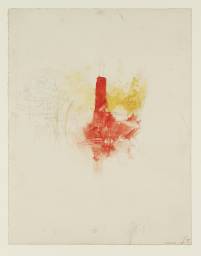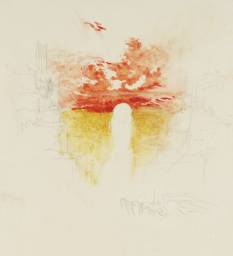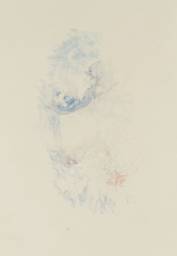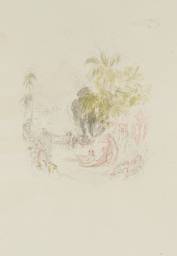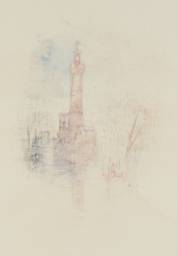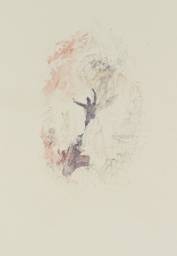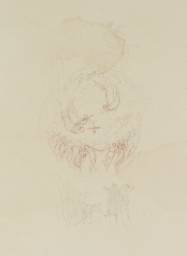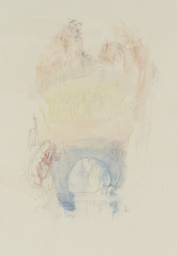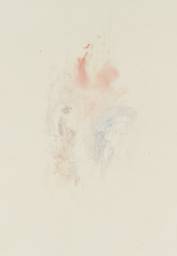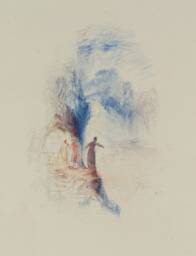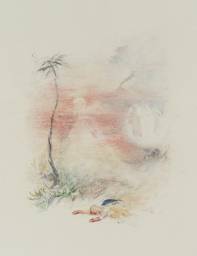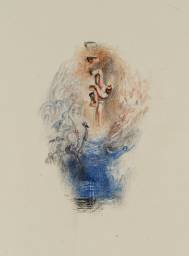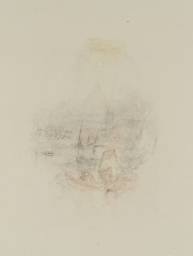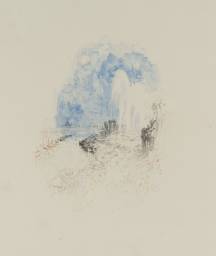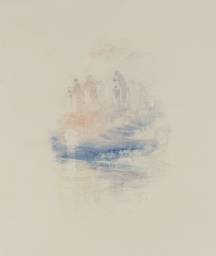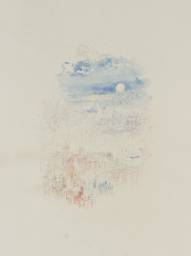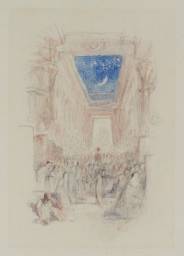Turner Bequest CCLXXX 77; 82; 113–117; 119–120; 122–134; 138
References
Turner and the Irish poet, Thomas Moore (1779–1852), met in 1819 whilst the two men were staying in Rome. Although the latter began writing his work The Epicurean, a Tale; and Alciphron, a Poem, shortly after leaving Italy, the finished version was not published until 1827. The book subsequently appeared in several editions, some in translation, before being republished in 1839 by the London publisher, John Macrone. This new edition contained four vignette illustrations designed by Turner. These watercolours, all of which were engraved by Edward Goodall, were the last of the artist’s vignettes to be published within his lifetime.1
Macrone had initially hoped to publish a complete collection of Moore’s prose and poetical works. The edition would have run to fifteen volumes, and was meant to include illustrations by Turner. However, the project met with numerous copyright difficulties and was eventually abandoned. The only book to emerge from Macrone’s original plan was the 1839 illustrated edition of The Epicurean. In the preface, the author explained how the publication came into being:
The idea of calling in the magic pencil of Mr. Turner, to illustrate some of the scenes of the following story, was first suggested by the late Mr. Macrone ... His original wish had been that I should undertake for him some new poem, or story, to be thus embellished by the artist. But other tasks and ties having rendered my compliance with this wish impracticable, he proposed to purchase of me the copyright of the Epicurean for a single ‘illustrated’ edition; and hence the appearance of the work under its present new auspices and form.2
Although Turner produced a number of finished watercolour drawings for The Epicurean, only four designs were ultimately engraved for publication: The Garden (private collection) The Ring, The Nile and The Chaplet, circa 1838 (all untraced).3 All four of these illustrations were initially owned by Turner’s friend and patron, H.A.J. Monro of Novar, and were sold in the Monro sale at Christie’s on 2 June 1877.
The Epicurean is at once a seductive oriental fantasy and a morality tale, which perhaps accounts for much of its appeal to nineteenth-century audiences. Moore’s story purports to be a translation of an ancient manuscript. It tells of Alciphron, a young, hedonistic Greek, who travels to Alexandria to find the secret of eternal life. There he falls in love with the beautiful Alethe, only to see her die a martyr for her Christian faith. Filled with evil spirits, narrow escapes, and moonlit trysts on the Nile, the content of The Epicurean would seem to lend itself well to illustration. However, the nature of the text may have made Turner’s task more difficult. In contrast to Rogers’s and Campbell’s poems which contain relatively little visual description, Moore’s prose is filled with incident and detail. When discussing the possibility of illustrating the publication, the painter George Jones (1786–1869) declared: ‘you do too much yourself: you leave hardly anything to the artist.’4 In order to discourage Turner from adhering too closely to his text, the author asked him to produce only ‘vague and unparticularised’ scenes and Moore would later express disappointment with The Ring, in which he felt that the artist had strayed too far from these instructions.5
The Turner Bequest contains three unpublished finished designs for Moore’s The Epicurean (see Tate D27645, D27646, D27647; Turner Bequest CCLXXX 128, 129, 130). The remainder of the group is preparatory studies that relate to the publication, or are tentatively identified as pertaining to the project. Ruskin grouped the majority of these studies together in a parcel labelled ‘A.B. 82. PM. Studies of Vignettes (Epicurean). Bad.’6 Finberg records how Ruskin later described his phrasing in a letter to Ralph Nicholson Wornum as ‘horrible’, adding ‘I never meant it to be permanent’.7 Turner’s vignettes for Moore are often considered to be his least successful literary designs. Rawlinson does not even make mention of them, stating simply that ‘after Campbell’s poems Turner... illustrated no future books of importance’.8 However, the large group of studies and watercolours relating to The Epicurean found in the Turner Bequest reveal the degree of care and preparation that the artist invested in this commission. Although most of the preliminary sketches bear little resemblance to the four subjects that were selected for publication, their reference to numerous details from Moore’s text clearly reflect the artist’s close engagement with his literary subject.
It is interesting to note the disparity between in Turner’s working methods for The Epicurean and an earlier illustrative project, The Poetical Works of Thomas Campbell (1837). In contrast to the loosely painted studies for Campbell’s poems, the sketches that Turner produced for The Epicurean are more complex compositions, filled with detail outlined in pencil. Ruskin was perhaps overcritical when he classified nearly all of the studies as ‘Bad’.9 Like the published vignettes for Moore’s Epicurean, the preliminary sketches possess an element of fantasy and high drama that is unique among Turner’s works of literary illustration. This is particularly true of the three unpublished finished designs for The Epicurean that have remained in the Bequest (see Tate D27645, D27646, D27647; Turner Bequest CCLXXX 128, 129, 130). In these works, the ethereal technique and pastel palette of these works combine with Moore’s fantastical subjects to create images of remarkable delicacy and imagination. Their fine quality led E.T. Cook to include them in his selection of Hidden Treasures of the National Gallery (published 1905). The author concluded, with mild but rightful indignation, ‘I cannot conceive why none of these is considered worthy of any better place than a brown-paper parcel in a tin box.’10
W.G. Rawlinson, The Engraved Work of J.M.W. Turner, R.A., vol.II, London 1913, nos.634–7. There are several impressions of the prints in Tate’s collection.
John Russell (ed.), Memoirs, Journal and Correspondence of Thomas Moore, London 1853, vol.VI, p.188.
How to cite
Meredith Gamer, ‘Watercolours Related to Thomas Moore, The Epicurean, a Tale, and Alciphron c.1837–8’, subset, August 2006, in David Blayney Brown (ed.), J.M.W. Turner: Sketchbooks, Drawings and Watercolours, Tate Research Publication, December 2012, https://www

